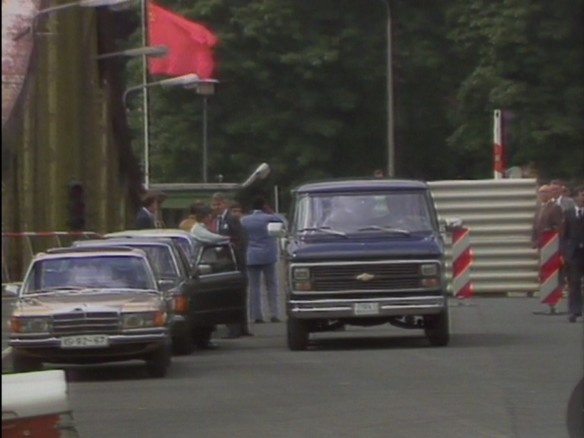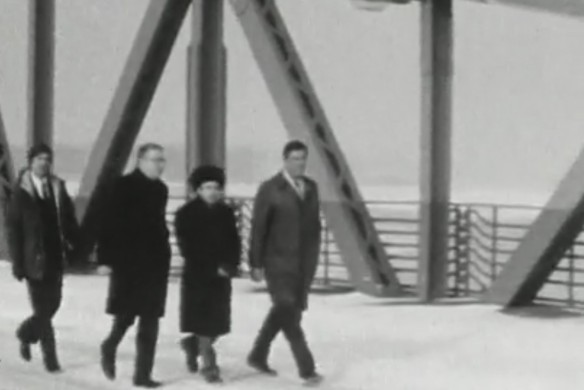 In Berlins ultimate southwest corner, the 128 meter long Glienicker Brücke connects Berlin with the city of Potsdam since 1660. It has been demolished and rebuild several times. Today, it is a whooping 105 years ago that this version of the bridge became in use.
In Berlins ultimate southwest corner, the 128 meter long Glienicker Brücke connects Berlin with the city of Potsdam since 1660. It has been demolished and rebuild several times. Today, it is a whooping 105 years ago that this version of the bridge became in use.
In 1660, the nobility needed a brigde to connect their palaces with their hunting sites. For a century, only the noblemen were allowed to use it. Only then (1756), the bridge became in public use. This saved the post company a detour of 4-8 hours. A few years later (1777) the bridge was renewed to fit the increased traffic. By then, it became a drawbridge with rails on the bridge’s sides and checkpoints on both sides. In the late 18th century, road tax was asked to pay for a new road between Berlin and Potsdam. Even now, the nobility did not have to pay any contribution.
In 1831, the wooden bridge was replaced by a brick bridge that’s designed by Prussian’s most famous Karl Friedrich Schinkel (1781-1841). Around the year 1900, an average of 400 cars and carriages passed over the bridge daily. In despite of protests, Schinkel’s yellowish stone bridge was demolished in 1906.
The iron bridge like we know it now, opened for traffic at November 18, 1907. Critics were mostly negative and said it looked too plump. Still, the buss-line from Zehlendorf till Potsdam turned the Glienicker Brücke into an attraction. Under national-socialism, the bridge was widened till 13 meter. The bridge was now part of the Reichsstraße 1, the project to secure a road with four lanes from Aachen till Königsberg. Towards the end of national-socialism, the bridge was destroyed. As a result of the infamous Nerobefehl (Nero Decree: the order to destroy German infrastructure to slow down the Allied armies), dynamite was placed at all pillars of the bridge. It wouldn’t make it through the war undamaged. As is often the case with such things, it remains unclear whether the German army blew it up willingly. Or was it a Soviet tank shell that accidently had a direct hit at one of the pillars?
The Glienicker Brücke was reopened in December 1949, now 11 meters wide. Ironically, the bridge was first given the nickname Brücke der Einheit (Bridge of Unity). In the middle of the bridge, a white stripe marked the border between the East Germany and West Berlin. However, cars were not allowed to cross the border since 1952. Pedestrians with valid papers could use the Bridge of Unity for another year. On the 3rd of July 1953, the bridge became out of use. Only military inspectors from France, the UK and the USA were allowed to cross for their patrols through East Germany.
At moments when the Cold War was less tense, the Glienicker Brücke became the location for exchanges. These would give the bridge its exiciting nickname: the Bridge of Spies. In three exchanges, fourty people were exchanged here. The Glienicker Brücke was chosen since it was easy to reach for both parties, with a surrounding that was easy to control. For example, the nearby Villa Kampffmeyer was a observation post of the KGB.
For an exchange, one needs participants. The first one to be arrested was Rudolf Abel, the nickname of Vilyam Genrikhovich Fisher. Abel gave information to the Soviet secret services concerning the US defense. He was arrested in June 1957 and convicted a few months later. In July 1959, the KGB already told Wolfgang Vogel -a Stasi negotiator who had the right connections and was trusted in the West- that they were interested in getting Abel back, even for an exchange.
The KGB had to wait about a year for a present falling from the sky. Gary Powers (1929-1977) worked for the CIA when his spy plane was shot down above Soviet territory. Powers was sentenced for three years in prison and seven years in a working camp. In August 1961, the East German police kidnapped Frederic Pryor. He studied East European studies at the Freie Universtität in West-Berlin. He researched currency in East European trade, apparently a touchy subject. Pryor was imprisoned without any charge.
Although the exchange of spies was supposed to stay secret, it leaked out and caused headlines in the media. It must have put extra pressure on the highly tensed situation. So, you would expect that the CIA and KGB made the exchange go smooth. Right?
 The day of exchange was February 10, 1962. At 8:20am, the American delegation walked up to the border at the middle of the bridge. With them was Joseph Murphy. As a close colleague of Gary, he had the task to identify him. When Gary walked towards the US delegation, guarded by two Soviets, Joseph walked towards them and asked Gary for the name of his football coach in high-school. Gary couldn’t remember the name and started to talk nervously about the dog he had when he was young. Joseph bought the story. Next, both teams had to wait for Frederic Pryor to have crossed Checkpoint Charlie. The icey situation lasted nearly half an our, when the confirmation came that Frederic Pryor was on Western soil. When Powers and Abel passed each other, there was no exchange of a word or even a nod. The exchange finished at 08:52am.
The day of exchange was February 10, 1962. At 8:20am, the American delegation walked up to the border at the middle of the bridge. With them was Joseph Murphy. As a close colleague of Gary, he had the task to identify him. When Gary walked towards the US delegation, guarded by two Soviets, Joseph walked towards them and asked Gary for the name of his football coach in high-school. Gary couldn’t remember the name and started to talk nervously about the dog he had when he was young. Joseph bought the story. Next, both teams had to wait for Frederic Pryor to have crossed Checkpoint Charlie. The icey situation lasted nearly half an our, when the confirmation came that Frederic Pryor was on Western soil. When Powers and Abel passed each other, there was no exchange of a word or even a nod. The exchange finished at 08:52am.
For the ones who think Gary Powers would live an easy life ever after, that’s wrong. The US public opinion at the time, thought Powers should have commited suicide. His wife left him. In contrast, Rudolf Abel was given the opportunity to teach Soviet agents about his spy activities.

Spy Exchange at the Glienicker Brücke. Still from a video from the ARD. ©ARD
The second exchange on the Glienicker Brücke took place the 11th of June 1985. In this, 25 political prisoners of East Germany and Poland (among them low ranked spies) were exchanged for four (high ranked) Soviet spies. Among the Soviets was Marian Zacharski (1951-). He had made photos of important documents, concerning radar technology and the Phoenix and Patriot missiles. For this exchange, both Ronald Reagan and Michael Gorbatsjov were present. It was planned that it would finish at 6pm. Already at mid-day, the Western deputees could check whether all 25 exchanged prisoners were on the eastern side of the bridge. A bit later, the 25 prisoners were released. Next, the four high ranked KGB officers walked to Potsdam. The exchange was already finished before 1pm. Smooth indeed.

Schtscharanski (moments before his trousers fell). Click for a video with English translations. ©RBB
The last exchange is the one I wanted to have attended the most. On the 11th of February 1986, five spies in American captivity were exchanged for four people who stayed in prisons behind the Iron Curtain. Media gathered in front of the bridge already days before the exchange. Especially the case of Soviet dissident Anatoli Schtscharanski complicated the exchange. Therefore, the US officials demanded that Schtscharanski was the first to cross the border. The exchange started at 10:42am. Schtscharanski came all by himself, as agreed upon. In an attempt to impress the media with an expression of freedom, he jumped over the line at the middle of the bridge. The thin rope of his oversized trousers broke: his pants fell down. The other spies were exchanged one by one, till the exchange was finished at 11:31am.
For once more, the Glienicker Brücke brought people into the Free West. It was in 1986 when three East German civilians succesfully used a truck to break through the border.
In November 1989, the day after the Berlin Wall fell, the bridge opened again for public traffic. The Bridge of Spies turned again into the Bridge for Unity. This time, for real. Still, the border between the former East and West can be noticed by the difference of the paint.
Recommended book:
Norbert F. Pötzl, Basar der Spione – Die geheimen Missionen des DDR-Unterhändlers Wolfgang Vogel (Hamburg 1997)




Pingback: Overview | Historical tales about the capital of the 20th century